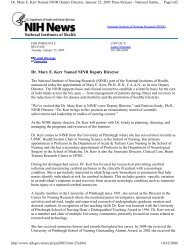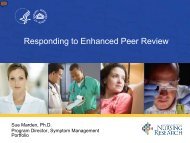End-of-Life Care - National Institute of Nursing Research
End-of-Life Care - National Institute of Nursing Research
End-of-Life Care - National Institute of Nursing Research
- No tags were found...
You also want an ePaper? Increase the reach of your titles
YUMPU automatically turns print PDFs into web optimized ePapers that Google loves.
Summary <strong>of</strong> the Capitol Hill Breakfast Briefing on<strong>End</strong>-<strong>of</strong>-<strong>Life</strong> <strong>Care</strong>March 16, 1998The FRIENDS <strong>of</strong> the NINR held the first in a series <strong>of</strong> three breakfast briefings this year on March 16, 1998. The topic was<strong>End</strong>-<strong>of</strong>-<strong>Life</strong> <strong>Care</strong>. FRIENDS, an independent, non-pr<strong>of</strong>it membership organization, supports the NINR by promoting publicawareness <strong>of</strong> the role <strong>of</strong> nursing research in advancing health care practice in the United States. Those attending thebriefing included Congressional staff, nurse researchers and administrators, and members <strong>of</strong> public and privateorganizations having a special interest in the topic.Colleen Conway-Welch, PhD, RN, FAAN, President <strong>of</strong> FRIENDS and Dean <strong>of</strong> Vanderbilt University School <strong>of</strong> <strong>Nursing</strong>,provided welcoming remarks and thanked the Congressional sponsors, Senator Ron Wyden (D-OR) and RepresentativeElizabeth Furse (D-OR). She also recognized Dick Thompson, Vice President <strong>of</strong> Government Affairs <strong>of</strong> Bristol-MyersSquibb, which hosted the breakfast.Patricia A. Grady, PhD, RN, FAAN, Director <strong>of</strong> the <strong>National</strong> <strong>Institute</strong> <strong>of</strong> <strong>Nursing</strong> <strong>Research</strong> (NINR), opened the scientificdiscussion by providing background information about NINR's involvement in end-<strong>of</strong>-life issues. NINR's research portfolioover the past 10 years has included issues related to end-<strong>of</strong>-life, such as decisionmaking and managing symptoms,including pain. The <strong>Institute</strong> is therefore well grounded to go forward with these lines <strong>of</strong> scientific inquiry and has beendesignated by the NIH as the lead <strong>Institute</strong> in the area <strong>of</strong> palliative care research.In the Fall <strong>of</strong> 1997, NINR convened a multidisciplinary workshop on end-<strong>of</strong>-life issues that identified four major areas inneed <strong>of</strong> research: pain, dyspnea (difficulty breathing), cognitive disturbances, and cachexia (weight loss and wasting). Aprogram announcement was issued in December to stimulate research in these areas. Other NIH <strong>Institute</strong>s joining NINRin issuing the program announcement were the <strong>National</strong> Cancer <strong>Institute</strong>, the <strong>National</strong> <strong>Institute</strong> <strong>of</strong> Allergy and InfectiousDiseases, the <strong>National</strong> <strong>Institute</strong> <strong>of</strong> Mental Health and the Office <strong>of</strong> Alternative Medicine.THE RESEARCH<strong>End</strong> <strong>of</strong> <strong>Life</strong> <strong>Care</strong> at Home: The Living Room as the Intensive <strong>Care</strong> Unit. Marcia Grant, RN, DNSc, FAAN, Directorand <strong>Research</strong> Scientist, Department <strong>of</strong> <strong>Nursing</strong>, <strong>Research</strong> and Education, City <strong>of</strong> Hope <strong>National</strong> Medical Center,Duarte, CaliforniaDr. Grant stated that as a result <strong>of</strong> improved health care, the nation's people are living longer lives but are also dying moreslowly. More than 2 million Americans will die in 1998, most from chronic illness that they have endured for a long period<strong>of</strong> time. More than 70% <strong>of</strong> deaths occur in those over 65 years <strong>of</strong> age. There has been a shift from patient care in thehospital to family care in the home, which presents a special challenge for health care pr<strong>of</strong>essionals as they adjust theirfocus on providing support for these caregivers.A 1997 <strong>Institute</strong> <strong>of</strong> Medicine report, Approaching Death: Improving <strong>Care</strong> at the <strong>End</strong> <strong>of</strong> <strong>Life</strong>, stated that people fear they willbe technologically overtreated, leading to a protracted death. They also fear abandonment and untreated physicaldistress. There are gaps in knowledge as to how to best treat patients at the end <strong>of</strong> life and how to meet caregiver needs.Recent surveys indicate family caregiver time spent in hands-on care can range from none to 15 hours a day. Theaverage is 4 * hours. More than 20% <strong>of</strong> patients need 10 hours <strong>of</strong> care a day. To illustrate her point that caregiving is "notjust chicken soup and fluffing pillows it's heavy duty," Dr. Grant provided an example <strong>of</strong> an end-stage patient withstomach cancer living at home. She had earlier experienced surgery, radiation and chemotherapy. Her family caregiverswere her husband and her daughter, who had recently given birth. The home became an intensive care unit (ICU), withfamily members managing pumps, feeding her by a tube that sometimes leaked, and dispensing medications. They had todeal with wound care, incontinence, drug dementia, and her pain, which was particularly difficult. There werepsychological problems for both the patient and the caregivers.Clearly more resources need to be devoted to assisting family caregivers. Dr. Grant indicated that key areas for researchinclude:
• Better pain management• Strategies for families that care for relatives in a home setting• Better transition from health care setting to home setting• Effective ways to educate the public and the medical community about end-<strong>of</strong>-life issues.Patient and Family Perspectives on <strong>End</strong>-<strong>of</strong>-<strong>Life</strong> <strong>Care</strong>. Virginia Tilden, RN, DNSc, FAAN, Pr<strong>of</strong>essor and AssociateDean, School <strong>of</strong> <strong>Nursing</strong>; Associate Director, Center for Ethics in Health <strong>Care</strong>, Oregon Health SciencesUniversity, PortlandIn providing background on the issues <strong>of</strong> end-<strong>of</strong>-life care, Dr. Tilden stated that technology can extend life far beyond thequality <strong>of</strong> life point. The majority <strong>of</strong> patients end up in the intensive care unit, <strong>of</strong>ten in pain, unable to communicate withloved ones. Most people do not want treatment if it is futile, but this can be difficult to judge. Many patients receiveaggressive care at the end <strong>of</strong> their lives for several reasons uncertainty about the prospects <strong>of</strong> death and when it mightoccur (no one wants to make a mistake), and a built-in unwillingness to give up on the part <strong>of</strong> the medical staff.Internists are treatment-oriented, not comfort-oriented. This can be expensive and denies the principle that patients arequalified to decide about their care. Aggressive medical treatments at the end <strong>of</strong> life are estimated to be many thousands<strong>of</strong> dollars more per patient than the costs <strong>of</strong> palliative care. For example, the cost <strong>of</strong> two days <strong>of</strong> hospital ICU care isroughly equivalent to that <strong>of</strong> 30 days <strong>of</strong> hospice care. A 1994 study <strong>of</strong> dying in the ICU found that 5% <strong>of</strong> patients that diedused 22% <strong>of</strong> the ICU resources. When staff knew the patient's wishes about treatment, however, an average <strong>of</strong> $14,000was saved per patient.Dr. Tilden described her joint (nursing/medicine) research project that began in 1990 and explores what patients andfamilies want and expect in end-<strong>of</strong>-life care. Some <strong>of</strong> her findings are as follows:• Families whose loved ones are dying in hospitals are willing to stop aggressive treatments if they understand thecondition is terminal and they are convinced their loved one will receive high quality comfort-care.• Families report that dying loved ones in the last week <strong>of</strong> life have much more pain and other physical distress,e.g., nausea, shortness <strong>of</strong> breath, than physicians and nurses think they have.• In the present health care environment in which patients are discharged quickly from one setting to another,discontinuity and lapses in health services are very distressing to patients and families.• Americans with inadequate health insurance lack access to good palliative care during dying. They are muchmore likely to arrive at emergency rooms in acute distress and require expensive hospitalization for symptomsthat could have been managed by hospice or home-health nurses.• A simple, bright pink form in the front <strong>of</strong> nursing home residents' medical records can prevent unwanted transferto the hospital when a resident is dying and prefers to stay in the nursing home.• For families whose loved ones died in a hospital, certain physician and nurse behaviors such as viewing death asa medical failure greatly increases the family's grief and distress.Dr. Tilden concluded her remarks by stating that affordable, high quality, low-tech home care, with the guidance <strong>of</strong> a nursepractitioner to effectively manage the symptoms <strong>of</strong> dying, such as pain, is the best alternative to a pain filled, lengthy andexpensive dying process or to assisted suicide.CHALLENGESSupportive care and symptom management during the final weeks and months <strong>of</strong> a patient's life have received littleattention, but it is becoming increasingly clear that distressing symptoms considered inevitable at the end <strong>of</strong> life can beeased and that a patient's quality <strong>of</strong> life, sense <strong>of</strong> control, and dignity can be maintained. Various issues remain to beresolved through multidisciplinary research:The increased aging <strong>of</strong> the population necessitates a strong focus on how the health care system manages end-<strong>of</strong>-lifecare. More needs to be known about the proper course <strong>of</strong> treatment during the dying phase.Despite the availability <strong>of</strong> painkillers, such as opioids, for terminally ill patients, reports indicate that pain is stillinadequately treated. For example, a recent <strong>Institute</strong> <strong>of</strong> Medicine study found that 40 to 80% <strong>of</strong> patients with cancer,AIDS, and other diseases report inadequately treated pain. Concern about patient addiction to drugs has been largelyunfounded.
There is a need for improved assessment tools to help health care pr<strong>of</strong>essionals properly evaluate symptoms at the end<strong>of</strong> life so that proper treatment may be prescribed. While pain is a major symptom, other symptoms include breathingdifficulties, cognitive disturbances, wasting and weakness, nausea, fatigue and depression. These symptoms <strong>of</strong>ten occurin combination and compound the suffering <strong>of</strong> dying patients and their caregivers.Patients' comfort needs and their wishes for end <strong>of</strong> life care must be respected. <strong>Research</strong> has found discrepanciesbetween patient desires and the treatment they receive at the end <strong>of</strong> life. A recent NIH investigation, "Study to UnderstandPrognoses and Preferences for Outcomes and Risks <strong>of</strong> Treatments" (SUPPORT), found that:Forty percent <strong>of</strong> the patients were treated aggressively in ICUsPain was commonly experienced by these patientsAlmost half <strong>of</strong> the physicians did not know that their patients preferred not to be resuscitatedFamily caregivers' needs must be addressed. They must become skilled in dispensing opiates, determining the changingfood preferences <strong>of</strong> a dying person, and responding to changes in functioning and types <strong>of</strong> care required. They must alsobe helped to cope with stress and maintain their own health.












